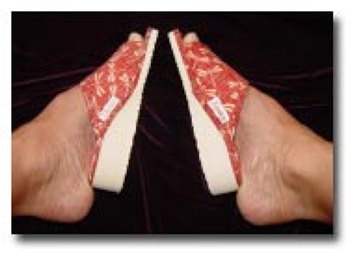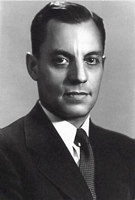Dieting and Weight Loss
Scale in Soda-Fountain Seat
Watch your weight increase as you eat.
Popular Science - Dec 1938
Posted By: Alex - Sat Aug 12, 2023 -
Comments (0)
Category: Inventions, 1930s, Dieting and Weight Loss
Ear Stapling (aka Staplepuncture)
Text from The Encyclopedia of Alternative Medicine and Self-Help (1978), edited by Malcolm Hulke:
What the Cleveland Health Clinic says about ear stapling:
What you won't see is any scientific proof to back those claims up or doctors extolling the practice's health benefits. There's some evidence supporting the use of auricular acupuncture for weight loss, but — while some acupuncturists offer the service — ear stapling isn't the same thing as auricular acupuncture.
The lack of scientific evidence supporting ear stapling for weight loss is one of the reasons most states don't regulate it — there'd need to be some evidence that the practice is legitimate, and there isn't any.
Posted By: Alex - Wed Aug 09, 2023 -
Comments (2)
Category: Dieting and Weight Loss
Ann Wigmore’s Recipes for Longer Life
Ann Wigmore believed that the secret to good health and a long life was eating 1) a lot of wheatgrass and 2) only raw food. If those appeal to you, you'll find lots of recipes in her cookbook below, Recipes for Longer Life (published in 1978, available at archive.org).Wikipedia says that she lived to be 84, which is a relatively long life, but not remarkable. She died of smoke inhalation from a fire. So maybe she would have lived much longer if not for that bad luck?
Wikipedia also says, "many of her claims were denounced as quackery, and her qualifications were never confirmed to be genuine."


I guess she wasn't keen on melons: "eat them alone or leave them alone".

Posted By: Alex - Fri Jun 16, 2023 -
Comments (3)
Category: Food, Cookbooks, Patent Medicines, Nostrums and Snake Oil, Dieting and Weight Loss
Calories Don’t Count
Dr. Herman Taller was arguably ahead of his time with his assertion that a high-protein diet was more effective for weight loss than simply restricting calories. However, it was his promotion of "CDC" (Calories Don't Count) capsules that got him into trouble. He claimed that these capsules not only would help with weight loss but would also lower cholesterol, treat heartburn, improve the complexion, increase resistance to colds, and boost the sex drive. The FDA disagreed, noting that the capsules primarily contained safflower oil. Taller was eventually convicted of mail fraud.More info: Wikipedia, Quackwatch

Posted By: Alex - Sun May 28, 2023 -
Comments (0)
Category: Health, Dieting and Weight Loss
Get Slim Slippers
These were mini slippers that supposedly helped one lose weight. How? Something to do with reflexology and magnets. And also, I assume, the extra effort required to balance in them.
They were sold via the website GetSlimSlippers.com, which no longer exists (but is archived at the Wayback Machine).
Quackwatch.org has an article by someone who tried them out to see if they would actually work:
Related post: Slimming Insoles
Posted By: Alex - Thu Mar 23, 2023 -
Comments (1)
Category: Shoes, Dieting and Weight Loss
The Great Starvation Experiment, 1944-1945
I wrote this brief article a number of years ago. It used to be posted on another site, which no longer exists. So I'm relocating it here. . .One of the greatest killers of World War II wasn't bombs or bullets, but hunger. As the conflict raged on, destroying crops and disrupting supply lines, millions starved. During the Siege of Leningrad alone, over a thousand people a day died from lack of food. But starvation also occurred in a more unlikely place: Minneapolis, Minnesota. It was here that, in 1945, thirty-six men participated in a starvation experiment conducted by Dr. Ancel Keys.

Group photo of the participants

Dr. Ancel Keys
The starvation experiment developed out of Keys' interest in nutrition. He realized that although millions of people in Europe were suffering from famine, there was little doctors could do to help them once the war was over, because almost no scientific information existed about the physiological effects of starvation. Keys convinced the military that a study of starvation could yield information that would have both humanitarian and practical benefits — because knowing the best rehabilitation methods could ensure the health of the population and thereby help democracy grow in Europe after the war. Having secured his funding, Keys set out on his novel experiment.
More in extended >>
Posted By: Alex - Tue Mar 07, 2023 -
Comments (5)
Category: Experiments, Nutrition, 1940s, Dieting and Weight Loss
Select-A-Size Mirror
The Select-A-Size mirror, invented by Milton Doolittle, had a knob you could turn to make yourself look slimmer or fatter. As explained in the 1976 Canadian patent:

Palm Beach Post - Mar 20, 1983
Posted By: Alex - Thu Mar 02, 2023 -
Comments (4)
Category: Patents, 1970s, Dieting and Weight Loss
Amorous Dietitian
Published in 1961. It's got an intriguing title. However, a review on Goodreads reveals that "The title and the cover text have nothing to do with anything in the book."More info: Pop Sensation

Posted By: Alex - Tue Feb 28, 2023 -
Comments (5)
Category: Books, 1960s, Dieting and Weight Loss
Grapefruit Diet Ad
"With success, comes class!"
Posted By: Paul - Sat Nov 26, 2022 -
Comments (2)
Category: Food, Fruit, Advertising, 1980s, Dieting and Weight Loss
Fat Distributor
"Mary Ellen Sage is using a gadget called a fat distributor."The image appeared in the Oklahoma City Times (June 5, 1972), accompanying an article titled "Medical Gimmicks, Magic Potions Trap the Unwary." Unfortunately the article didn't elaborate on how exactly the fat distributor was supposed to work, beyond what the caption said. But I suppose it's self-evident. You rolled it over your body, and it distributed the fat!

Source: Oklahoma Historical Society
Posted By: Alex - Fri Oct 28, 2022 -
Comments (3)
Category: Patent Medicines, Nostrums and Snake Oil, 1970s, Dieting and Weight Loss

| Who We Are |
|---|
| Alex Boese Alex is the creator and curator of the Museum of Hoaxes. He's also the author of various weird, non-fiction, science-themed books such as Elephants on Acid and Psychedelic Apes. Paul Di Filippo Paul has been paid to put weird ideas into fictional form for over thirty years, in his career as a noted science fiction writer. He has recently begun blogging on many curious topics with three fellow writers at The Inferior 4+1. Contact Us |




